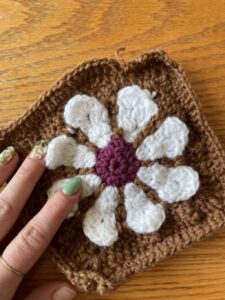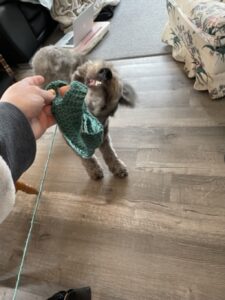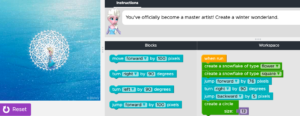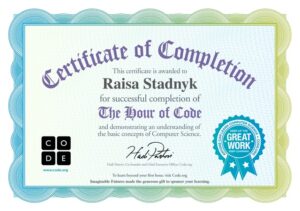Please find the link to a Slides presentation with examples of my interactions online with others!
Category: EDTC300
Summary of Learning in EDTC300
Watch this video to hear a highlight reel of all of the very important things I learned in EDTC300!
Learning Project Conclusion: What did I learn?
When I reflect on this learning project, I can conclude that I am not very good at crocheting… BUT I did learn a whole lot about the Internet, technology, and the world of online learning.
One of the first things I learned is how difficult it is for me to follow directions that are only written. I knew I was more of an auditory learner when it comes to information processing and memory, but I am surprised with how much easier it was for me to follow instructions when I could visually see the steps being done. I found that the easiest patterns to follow were ones that were demonstrated visually and spoken. The most difficult patterns to follow were ones that were just written. The differentiation in my own learning reinforces the importance of providing variance when delivering instructions to students.
Another aspect of my learning through this project is the development of my video editing skills. I have wanted for a while to learn how to better edit videos, but one of my problems was what? What can I film so that I can learn to edit? Insert learning project. I had something to film and a space to learn something, fail, try again, and develop techniques in the video editing space. Through what I have learned, I have been shooting, editing, and posting other types of content which brings me so much joy (here is a link to my most recent TikTok that is not about crochet, but demonstrates what I have learned about editing). I have been having a lot of fun with video content on social media! Social media proved itself to be a great resource for learning a new skill, and I continue to use social media as a place for inspiration regardless of the avenue.
One last concept I learned about is that it is okay if things don’t work out. Failure is a blessing and a lesson. As an ‘I need to be good at everything I do’ person, this is a big step. I am not good at crocheting, but does that mean I can’t just enjoy the process even if my projects look like balls of tangled up yarn? No. I can make tangled yarn messes if that’s what my little heart desires!
All in all, I learned quite a lot through this process, both about technology and about myself.
Thanks for following along friends, cheers!
Forgotten Flower
It seems that in the hubbub that is Winter semester, I forgot to post this absolute masterpiece*! How could I?



*in my, humble, opinion
I remember working very diligently on this square, and I am delighted with how it turned out. I adore the dimensional detail in the flower petals and the overall style of the square. I followed a Youtube video for this retro granny square that was unbelievably informative. I remember thinking that if someone entirely brand new to crocheting picked up a hook and watched this video, they would likely be able to follow along. The creator explained and demonstrated each step in detail; it really was like making the square with someone there to guide you.
If you are new to crochet, I would definitely recommend checking this video out!
Will Sully Approve…?
I have recently been working on making Sully (my dog) a hat! Since the bandana went over so well with him, I decided to work on something else for him. I have been enjoying these projects because I am making them for someone other than myself, and because they are smaller in scale and easier to work on with the busy schedule of a student.
The pattern I am following is written and not a video like I usually like, but it is somewhat easy to follow and is helping me retain the crochet lingo and abbreviations. I also adapted the pattern a little bit to better suit my skill level, such as only using one colour instead of switching yarn colours and creating an unnecessary mess that has the potential to become frustrating. I am also trying to remember to not get caught up by the small stuff. Creating is the goal not perfection.
I haven’t quite finished the hat yet, but I will likely get a chance once finals and spring cleaning have both wrapped themselves up!


Here are some photos of the unfinished hat, so you can kind of get an idea of what it is going to look like. I think Sully will approve, but what do you think? Will the hat be up to his standards?

AI: Where will you use it?
I toured around the Magic School site (and got a 14 day free trial of their plus option) and found that the program would be useful in accomplishing administrative tasks that can take away from the important work teachers should be able to spend more time on. It looks like Magic School can draft emails, rubrics, multiple choice questions, permission forms, lesson plans, IEPs, and many other types of documents.
When teachers are working with multilingual and newcomer families, it is often the responsibility of the family to translate information from the school. Magic School has a few tools that can translate emails and other text into multiple languages which can aid both the teacher and families in daily classroom correspondence.
However, a tool on Magic School that I am sceptical of using is the report card comment generator. I personally feel that comments on reports should be generated naturally by the teacher. In using some of the other tools in Magic School that can lighten the administrative load, the teacher will be able to spend more time engaging with students and generating genuine reports based on those interactions.
There are some clerical tasks that I feel can be delegated and satisfactorily completed by AI. These tasks are more general and less personal, but when I am a teacher I will be manually completing the tasks that require tailored responses. Report cards, some lessons, and some IEP sections should be done by humans, but some tasks are able to be completed from AI.
Regardless of where you stand, AI is here and can support so many tasks. It is up to you and your level of comfort with AI that will determine how much or little of it you use and what kind of tasks you delegate to AI.
What are we doing to each other online?
In her TedTalk, Monica Lewinsky discusses the need for a cultural revolution when it comes to the nature of internet users to publicly shame individuals for transgressions that were meant to stay private. She challenges the public to value compassion and empathy instead of valuing humiliation. Lewinsky also discusses humiliation as a commodity and shame as an industry that is fuelled by clicks and makes money on the back of someone else’s suffering. These are huge topics that Monica has faced in her life and has been able to find some clarity in as a 40-something woman. When we put these big topics in the context of being in a child’s online reality… the consequences are so much more likely to be catastrophic.
Lewinsky does touch on the subject of children facing these challenges online and not being developmentally equipped enough to handle the situation. I truly hope that if I in the future have a student that is dealing with online public humiliation, that they are willing to share with me so that I can offer them some form of compassion. Lewinsky mentioned that leaving positive messaging when cyber-vigilantism is running its course can be a way to mitigate the negativity and break the mob-mentality that fans the flames of shame fires.
What are we doing? Have we determined that it’s now okay to be evil to people we don’t know as long as it happens on the internet?
There is a major lack of all the things we learned in kindergarten when it comes to the behaviour of society online. While I can understand that most of the internet’s users that engage in cyberbullying on a large scale did not grow up learning about digital citizenship in school, I can assume that most of them went to kindergarten. I honestly think it may be over for the adults of today to change the way they react online, but it is not too late for our youth. With algorithms feeding online users what they want and no physical gathering place to relay information, cyber-vigilantes are unlikely to receive any messaging pertaining to why what they are doing is wrong. It is our responsibility as teachers to teach our students about how to be kind online.
Hand-in-Hand: Digital Literacy & Critical Thinking
The premise of digital literacy has become so intricate that it is difficult to keep up, especially if you are not a regular user of internet media. It is easy to stay in your own corner of the internet and allow what you see to dictate what you think. In our classrooms, we should be teaching about how to be digitally literate and how to critically think about what we are seeing online, especially as it pertains to politics and human rights.
Data & Society Research Institute warns about the dangers of falling victim to political propaganda. The article highlights some of the tactics that trolls may use in order to manipulate internet users into believing their rhetoric (Data & Society Research Institute, p. 5&7). One method that can be used in elementary classrooms is to identify the emotional reactions that certain content brings, and ask if the content makes sense or seems rational. We can teach students to employ their critical thinking skills, like the ones we use in math when reviewing an answer, while we are viewing content online.
This list compiles ways to beat fake news, which can be taught in the classroom. Oftentimes when I am working with younger students I may say something a bit outlandish then ask “do you think Miss Standyk is telling you a true fact or is she being silly/pretending?” then get the student to respond and tell me why they think I am pretending. I believe this is a great way to stimulate critical thinking and begin to teach kids to question and critically think about what they see and hear, even from adults. When working with older students, the opportunity to use online resources that teach digital literacy is much more prevalent, but beginning to cultivate the skills required to think critically are important in the younger years.
In this book about teaching critical thinking, I especially like the lesson about using ads to teach persuasive writing. This lesson not only includes the basics of reading and writing, but asks kids to think about the ways that products and services are sold to them. They then have the opportunity to practice this writing which promotes their ability to identify persuasive language in the real world.
Back to the Basics
After my little pause on crochet projects, I was inspired to return to the basics after watching this TikTok video explaining some crochet basics. I decided to crochet a few rows as a fidget while being mindful of the basics, and WOW I improved! It’s interesting when something becomes easier by simply hearing it explained in a different way. This is something I often think about when working on skills with kids, but rarely apply to myself. It’s definitely something to be mindful of in the classroom.
The TikTok that I watched was awesome, because the creator went slowly and fully explained each step. There were so many tips and tricks I either picked up or forgot were necessary, like holding the proper amount of tension on the yarn. I definitely prefer learning crochet through TikTok or Youtube because of how easy it is to pause the video and rewind if necessary, as opposed to Instagram reels.

When I started feeling confident in my basic skills again, I looked up a tutorial on how to make a dog bandana. I came across this video which caught my attention due to the title claiming it was beginner friendly. I definitely agree with the title, because it was super simple to follow! I really liked that the creator emphasised throughout the video that it’s okay if every stitch doesn’t line up, and “try your best to…, but if you don’t that’s okay”. I definitely gained confidence in my skills and didn’t feel like if it wasn’t perfect I’d have to start again. Perfectionism is likely a culprit in my previous crocheting aversion, but no longer is.
Now, please enjoy this photoshoot of my doggo (Sully) in his brand new, adorable bandana!



Cracking the Code!
I had so much fun this week using Hour of Code to create snowflakes with Elsa and Anna! I had this student once as an EA who said “no-plakes” and it was so cute once I figured out what he was saying. Anyway, I did learn a lot about being specific in giving the computer directions in order to get the design I wanted, or trace the template I was prompted with.

While I was working on my snowflakes, I was inspired to think about the ways we can incorporate coding into other subjects. For example, I was thinking about using coding in procedural writing, but I was also thinking of using coding in math. You can pose the question relative to what they are learning, teach the steps to achieve the solution, then apply the steps to solving the problem/equation to writing a code. Students can then test their codes and use different numbers/situations for the codes that they write. What I would find most interesting are the different ways in which students may think about certain equations, and you would be able to gain some insight into their thinking processes.
Of course, websites like Hour of Code provide teachers with activities that relate to certain topics and subjects. Most of these pre-set coding activities could be worked into a subject to bring a lesson to life and further engage students in their learning while incorporating something new and fun!
